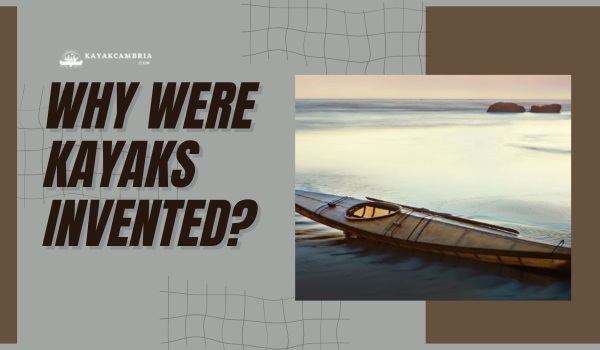The kayak is a fascinating invention that’s been around for centuries. But who exactly came up with this brilliant idea? In my research, I found that the Inuit people were the first to invent the kayak. They lived in the Arctic regions of North America and Greenland, where they needed a durable and efficient mode of transportation for both hunting and travel purposes.
The Inuit crafted their kayaks using materials they had readily available in their harsh environment. They used driftwood or whale bones to create the frame, and they covered it with sealskin to make it watertight. This allowed them to navigate icy waters with ease and silence, which was essential for successful hunting expeditions.
The kayak invention is thought to have occurred around 4,000 years ago. Its functional and resourceful design has since been adapted and refined by various cultures throughout the years. Today, kayaks are used for a wide range of activities, including recreational adventures, fishing, and even Olympic sports. The kayak’s continued popularity is a testament to the ingenuity of the Inuit people who first brought it to life.
Contents
Contents
Origins of the Kayak

Kayaking is a popular water sport enjoyed by many around the world, and its invention can be traced back thousands of years. But who invented the kayak? Let’s dive into the fascinating history of this ingenious creation.
The kayak’s invention is credited to the indigenous people of the Arctic region, specifically, the Inuit, Yup’ik, and Aleut cultures. These ancient tribes were skilled hunters and fishermen, and they created the kayak as a means to efficiently and stealthily navigate the icy Arctic waters. The word “kayak” itself is of Inuit origin, meaning “man’s boat” or “hunter’s boat.”
The first kayaks were crafted from lightweight and durable materials available in the Arctic region. Driftwood and whalebone were used to construct the frame of the kayak, while the skin of seals or other animals was stretched over the frame to make a watertight covering. This resulted in a highly maneuverable and buoyant vessel that allowed hunters to easily navigate narrow waterways and sneak up on their prey. Some common features of early kayaks include:
- Cockpit: a small opening where the user sits, typically with a tight seal to prevent water entry
- Sprayskirt: a flexible waterproof covering worn by the user to further prevent water from entering the cockpit
- Paddle: a double-bladed paddle used for propulsion
Over the years, kayak designs evolved, as modifications were made to suit various purposes, such as whaling, transportation, and recreation. European explorers who encountered the indigenous people of the Arctic in the 17th and 18th centuries admired the efficiency of the kayak and brought the knowledge of kayak construction back to their homelands.
Eventually, kayaks made their way to North America. In the late 19th and early 20th centuries, recreational kayaking became increasingly popular, marking the transition of the kayak from a traditional hunting tool to a modern water sport. Various materials have been used to construct modern kayaks, such as wood, fiberglass, and plastic. Nowadays, we also have a wide range of kayak types to suit different needs, including:
- Sit-on-top: a stable kayak with a user-friendly design for those new to the sport
- Inflatable: a kayak made from durable, lightweight, and easy-to-store materials
- Folding: a collapsible kayak that can be easily transported and stored
- Tandem: a double kayak designed for two paddlers
By tracing the kayak’s transition from traditional hunting tools to contemporary water sports, we not only gain a better understanding of the kayak’s history but also appreciate the ingenuity and resourcefulness of the Arctic people.
Indigenous People and Kayak Development

It’s essential to step back in time to truly appreciate who invented the kayak. The kayak’s origins can be traced back to the Arctic region, where the indigenous people relied on small, light and portable watercraft for their survival. The Inuit, Yup’ik, and Aleut tribes developed the first kayaks thousands of years ago to navigate their challenging environments and easily traverse the vast expanses of water.
While constructing these early kayaks, the indigenous people cleverly utilized materials readily available in their surroundings. The kayaks’ mainframes were fashioned from driftwood or whalebones, with the boat’s exterior covered in sealskin. Resourcefulness didn’t stop there; they utilized animal fats to make their watercraft waterproof, ensuring a more efficient and secure method of transportation.
The design of each kayak varied slightly among the different Arctic tribes, reflecting the environments they navigated and the specific purposes they aimed to serve. For example, the Greenlandic peoples built longer, narrower kayaks for open-water hunting. In turn, Alaskan tribes chose a shorter and wider design, more suitable for river hunting. Below are some of the basic design variations:
- Greenlandic kayaks: long, narrow, with steeply sloped sides
- Alaskan kayaks: short, wide, with a flatter bottom hull
These distinct kayak designs also accommodated the hunting techniques practiced by various tribes:
- Baidarka: Aleut tribes from Alaska invented this “double-paddle” kayak, allowing a single paddler to create significant momentum and speed.
- Umiak: Primarily used by the Inuit, Yup’ik, and Chukchi peoples of Alaska, Canada, and Russia, the Umiak was a larger, open-decked counterpart to the traditional enclosed kayak, used for transportation and hunting larger marine animals.
- Kayaks with sails: Certain tribes added sails to their kayaks for greater maneuverability, enabling them to cover vast distances without constant paddling.
By examining these early kayak models, we recognize that indigenous people of the Arctic played a crucial role in the invention and development of the kayak. These watercraft allowed tribes to adapt to their harsh surroundings, hunt successfully, and keep their communities alive.
European Influence on Kayak Design

Kayaks have a rich history that can be traced back thousands of years. Originally, they were constructed by the indigenous people of Arctic North America, known as the Inuit. However, as time went on, European explorers and travelers brought their own perspectives and innovations, leading to the development of the kayak designs we see today.
Throughout the 17th and 18th centuries, European explorers and travelers encountered kayaks in their journeys to North America. Fascinated by their utility and efficiency, they began adopting the kayak’s design for their own needs. While maintaining the traditional skin-on-frame structure of the Inuit’s design, Europeans introduced new materials and techniques to improve the kayak’s performance.
Some significant contributions from Europeans include the adoption of canvas materials for the kayak’s outer layer, replacing the animal skins used by the Inuit. This change provided greater durability and water resistance, while still being lightweight and flexible. Additionally, the folding kayak was a noteworthy innovation made by Europeans, which allowed for easy transportation and storage.
With the interest in kayaking spreading throughout Europe, various clubs and organizations began to emerge. In the late 19th century, the concept of competitive kayaking took shape. This development further fueled innovations in kayak design, catering to the specific needs of various types of kayaking:
- Slalom kayaking
- Whitewater kayaking
- Flatwater sprint racing
- Sea kayaking
As various European nations turned their attention to kayak design, they experimented with different shapes and materials, like wood and metal. By the early 20th century, the use of fiberglass and later plastic transformed the kayak industry, making the crafts lighter, stronger, and more affordable. This paved the way for the popularity of recreational kayaking that we see today.
While the kayak’s invention can be credited to the Inuit people, European influence played a significant role in shaping the kayak as we know it today. Innovations in materials, functionality, and competitive sports drove the transformation of kayaks from traditional Inuit watercraft to a versatile and widely popular vessels. It’s through this fascinating journey of adaptation and evolution by various cultures that the modern kayak was born.
Modern Kayak Evolution

When delving into the world of kayaks, it’s essential to understand how they’ve evolved over the years. The modern kayak has come a long way since its inception by the indigenous Inuit people of the Arctic region. Let’s explore the fascinating journey of the kayak’s development, along with identifying the key advancements that have shaped its current design and capabilities.
The origin of the kayak can be traced back thousands of years to the Arctic regions, where it was primarily used for hunting and fishing by the Inuit, Yup’ik, and Aleut peoples. These traditional kayaks were made from wood or whalebones and had a skin covering, usually made from seal or walrus hides. While these basic designs were effective at the time, they evolved significantly throughout history.
I’ve found that the transition from traditional to modern kayaks began in the mid-20th century. European enthusiasts saw the potential in the kayaks’ design, leading to the invention of the folding kayak. These were created by using a wooden or aluminum frame that could be easily disassembled and covered with a waterproof fabric material.
With the rise in popularity of kayaking as a recreational activity, significant advancements were made in kayak construction materials:
- Fiberglass kayaks emerged in the 1950s, which were lighter and more durable than their predecessors.
- Polyethylene kayaks were introduced in the 1980s, offering an even more affordable and robust construction.
The modern kayak’s design has been influenced by a host of kayak innovations over the years:
- Sit-on-top kayaks allow for a more open cockpit and are ideal for beginners and warm water conditions.
- Inflatable kayaks provide a portable and affordable option for casual kayakers.
- Tandem kayaks, or double kayaks, cater to those who prefer to paddle with a partner.
Additionally, the introduction of foot pedals and rotating seats have greatly enhanced the kayakers’ ability to control and maneuver their vessels.
In recent years, there has been a growing trend in specialized kayak designs for various water activities:
- Whitewater kayaks: specifically designed for tackling rapids and fast-moving currents.
- Sea kayaks: built for longer trips and rougher water conditions.
- Recreational kayaks: versatile, stable, and perfect for calm waters and general paddling.
With this comprehensive look at the evolution of the modern kayak, it’s clear that the sport has come a long way since its humble beginnings in the Arctic. Today’s kayaks are the culmination of centuries of innovation, offering a tailored experience for every paddler’s unique needs and preferences.
Why Were Kayaks Invented?

The harsh conditions of the Arctic environment dictated the need for versatile and reliable watercraft. Kayaks were created out of necessity as the perfect way to navigate the icy waters. Traditional kayaks were developed in response to specific local challenges, such as limited resources, rough seas, and the need to catch marine life as a primary source of sustenance.
Inuit and Aleut craftsmen built their kayaks using readily available materials. The traditional kayak’s frame was constructed from wood or, in some cases, whalebone for added structural integrity. The wood was often sourced locally, including driftwood found along the shorelines. The frame was then covered with stitched-together animal skins, like seal or walrus, which were treated with natural oils to waterproof the kayak.
One of the most distinctive features of the traditional kayak is its snug-fitting cockpit, designed to keep the paddler warm and reduce exposure to cold Arctic winds and water. The Inuit and Aleut hunters would wear a waterproof garment called a tuilik, which was fastened to the kayak’s cockpit to create a water-tight seal. This clever design also prevented water from entering the kayak, which was particularly important during hunting expeditions when the element of surprise was crucial.
Over time, the basic design of the kayak has remained relatively unchanged, with occasional adaptations due to regional variations and specific uses. Notable examples include the Greenland kayak, which boasts a narrower design suited for speed, and the Aleutian baidarka which features a bifurcated bow to handle rough Arctic waters.
As the years passed and cultures crossed paths, the kayak eventually became known to Europeans who were enthralled by this unique watercraft. In the 1800s, Europeans started emulating the form of the kayak for recreational and sports purposes. Modern kayaks, which are made predominantly of synthetic materials such as polyethylene, fiberglass, or Kevlar, gradually evolved from their Arctic forebears.
Today, the kayak has transformed from its original purpose as a hunting and fishing vessel for the Arctic people to a diverse craft suitable for various activities such as touring, whitewater paddling, and sea kayaking. Competitive disciplines, such as kayak sprint and slalom, are now a part of the Olympic Games, underscoring the kayak’s global appeal.
What Came First – The Kayak or Canoe?

I have always been fascinated by the history of watercraft, especially when it comes to indigenous peoples and their connection to water. One might often wonder which came first, the canoe or the kayak? It’s like the chicken and the egg question but for water vessels.
The canoe came first, as it is believed that it was developed around 10,000 years ago by indigenous peoples in the Americas. The oldest canoe ever discovered is the “Pesse Canoe,” which is estimated to be around 8,000 years old. This canoe was found in the Netherlands and gives an insight into the different types of watercraft that existed thousands of years ago.
The kayak, on the other hand, was developed approximately 2,000-5,000 years ago by the indigenous peoples in the Arctic region, specifically the Inuit, Yupik, and Aleut peoples. The name “kayak” comes from the Inuit word “qajaq,” which means “man’s boat” or “hunter’s boat.” The kayak was used for hunting and fishing in the harsh Arctic environment, where paddling a canoe with oars would be too cumbersome and not suitable.
What is the Difference Between a Canoe and a Kayak?

It’s essential to understand the differences between two similar watercraft, the canoe, and the kayak. While both are narrow and pointed at each end, there are several notable distinctions that differentiate the two.
First, the position of the paddler matters. In a canoe, I usually sit on a raised seat or kneel inside, whereas, in a kayak, I sit in a cockpit with my legs extended in front. Additionally, the paddle differs significantly. A canoe paddle typically has one flat blade on one end, and I use it to alternate strokes on either side of the boat. In contrast, a kayak paddle has two blades, one on each end, allowing me to simultaneously maneuver by dipping the blades on both sides of the kayak.
Conclusion
After delving into the history of kayaks, it’s evident that pinpointing a single inventor isn’t possible. The origins of the kayak can be traced back to the indigenous people of the Arctic region, particularly the Inuit, Yup’ik, and Aleut tribes. These ingenious communities developed the kayak as a practical and efficient tool for hunting and transportation in a harsh environment.
Some key points to remember about the invention of the kayak:
- Indigenous Arctic communities such as the Inuit, Yup’ik, and Aleut tribes were the original designers of kayaks.
- The word “kayak” derives from the Inuit word “qajaq” which means “man’s boat” or “hunter’s boat.”
- The earliest kayaks were constructed using driftwood or whale bones and covered with seal or caribou skins.
Today’s modern kayak designs and materials have come a long way from their ancient counterparts, reflecting the immense expansion of recreational and professional kayaking over the years. However, the underlying principles remain true to the Arctic tribes who first conceived and skillfully engineered these durable, versatile vessels.
In the end, answering the question “Who invented the kayak” may not lead to a specific inventor, but it does shed light on the rich history and cultural legacy of the Arctic communities who have significantly contributed to our understanding and use of kayaks today.
As kayaking continues to be a popular activity for people around the world, we should remember and acknowledge the innovative spirit of the Inuit, Yup’ik, and Aleut tribes that shaped this incredible invention.

